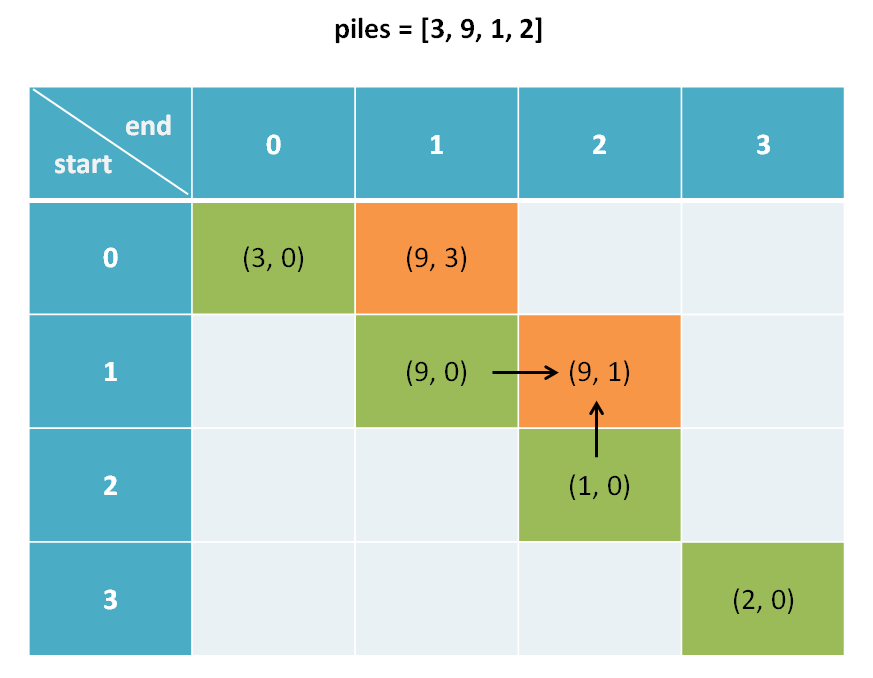标签:case nts lin 情况 alt str load HERE png
参考:https://labuladong.gitbook.io/algo/dong-tai-gui-hua-xi-lie/dong-tai-gui-hua-zhi-bo-yi-wen-ti
问题:
给定一堆石子的得分。A和B两个人进行如下游戏,
轮流,从石堆的两边选择一个石子,最终获得得分最大的人获胜。
由A先开始,求最终A是否能获胜。获胜则返回true,否则返回false。
Example 1: Input: piles = [5,3,4,5] Output: true Explanation: Alex starts first, and can only take the first 5 or the last 5. Say he takes the first 5, so that the row becomes [3, 4, 5]. If Lee takes 3, then the board is [4, 5], and Alex takes 5 to win with 10 points. If Lee takes the last 5, then the board is [3, 4], and Alex takes 4 to win with 9 points. This demonstrated that taking the first 5 was a winning move for Alex, so we return true. Constraints: 2 <= piles.length <= 500 piles.length is even. 1 <= piles[i] <= 500 sum(piles) is odd.
解法:DP(动态规划)
1.确定【状态】:石头堆 [ i ~ j ] 的
2.确定【选择】:对于先下的选手dp[i][j].first,分两种情况,取其中的最大值
3. dp[i][j]的含义:
将第 i 个石子到第 j 个石子最为对象石头堆,在这其中,所能获得的最大得分。
4. 状态转移:
dp[i][j].first = max {
5. base case:
6. 遍历顺序:
根据状态转移公式,在求得dp[i][j]之前,需先求得dp[i+1][j],dp[i][j-1]
因此需要:i:大->小,j:小->大 遍历

代码参考:
1 class Solution { 2 public: 3 //dp[i][j].first : among piles[i~j], the max points that the 1st player can get. 4 //dp[i][j].second: among piles[i~j], the max points that the 2nd player can get. 5 //for the 1st player: dp[i][j].first = ? 6 // case_1: choose piles[i]: = piles[i] + dp[i+1][j].second 7 // thus for the 2nd player can only choose from the left piles[i+1~j] 8 // dp[i][j].second = dp[i+1][j].first 9 // case_2: choose piles[j]: = piles[j] + dp[i][j-1].second 10 // thus for the 2nd player can only choose from the left piles[i~j-1] 11 // dp[i][j].second = dp[i][j-1].first 12 // base case: 13 // there is only one stone left. 14 // dp[i][i].first = piles[i] 15 // dp[i][i].second = 0 16 // target: 17 // dp[0][size-1].first > dp[0][size-1].second 18 bool stoneGame(vector<int>& piles) { 19 int n = piles.size(); 20 vector<vector<pair<int, int>>> dp(n, vector<pair<int, int>>(n, pair<int,int>(0,0))); 21 for(int i=0; i<n; i++) { 22 dp[i][i].first = piles[i]; 23 } 24 for(int i=n-2; i>=0; i--) { 25 for(int j=i+1; j<n; j++) { 26 int left = piles[i]+dp[i+1][j].second, right = piles[j]+dp[i][j-1].second; 27 if(left >= right) { 28 dp[i][j].first = left; 29 dp[i][j].second = dp[i+1][j].first; 30 } else { 31 dp[i][j].first = right; 32 dp[i][j].second = dp[i][j-1].first; 33 } 34 } 35 } 36 return dp[0][n-1].first > dp[0][n-1].second; 37 } 38 };
?? 优化:
空间复杂度:2维->1维
去掉 i
压缩所有行到一行。
左下角dp[i+1][j-1]会被上面的dp[i][j-1]覆盖,因此引入变量pre,在更新dp[i][j-1]之前,保存dp[i+1][j-1]
比原先的这种赋值方式,少了黄色的方块区域,刚好不会存在需要的黄色区域被上方的绿色区域覆盖的情况。
因此直接去掉 i 即可。
?? 注意:
1. 在初始化的时候,最开始的一行,和每一行(遍历 i)时的第一个元素dp[i],需要首先初始化。(如下述代码L7~L11)
2. 本问题的first和second两个值的赋值先后问题需注意。(不要被覆盖:如下述代码L15~L18)

代码参考:
1 class Solution { 2 public: 3 bool stoneGame(vector<int>& piles) { 4 int n = piles.size(); 5 vector<pair<int, int>> dp(n, pair<int,int>(0,0)); 6 7 dp[n-1].first = piles[n-1];//initialize 1st row. 8 dp[n-1].second = 0; 9 for(int i=n-2; i>=0; i--) { 10 dp[i].first = piles[i];//initialize 1st item of a row. 11 dp[i].second = 0; 12 for(int j=i+1; j<n; j++) { 13 int left = piles[i]+dp[j].second, right = piles[j]+dp[j-1].second; 14 if(left >= right) { 15 dp[j].second = dp[j].first; 16 //here *.first will be overwritten, 17 //so pay attention to the updating sequence of the pair. 18 dp[j].first = left; 19 } else { 20 dp[j].first = right; 21 dp[j].second = dp[j-1].first; 22 } 23 } 24 } 25 return dp[n-1].first > dp[n-1].second; 26 } 27 };
标签:case nts lin 情况 alt str load HERE png
原文地址:https://www.cnblogs.com/habibah-chang/p/13644782.html